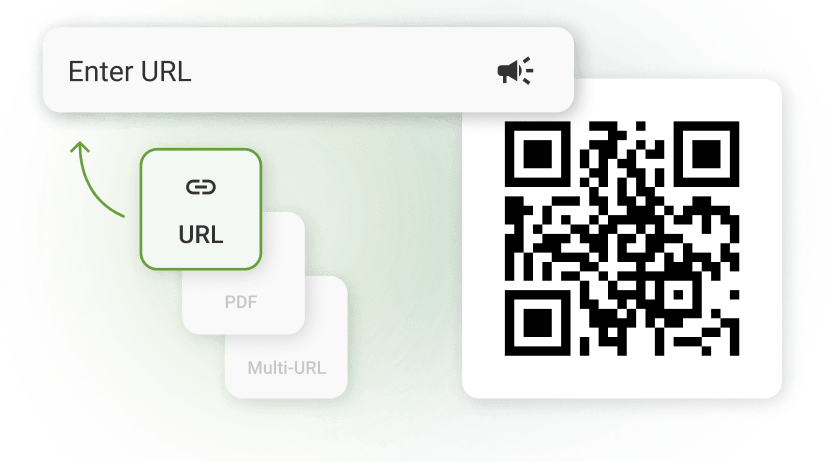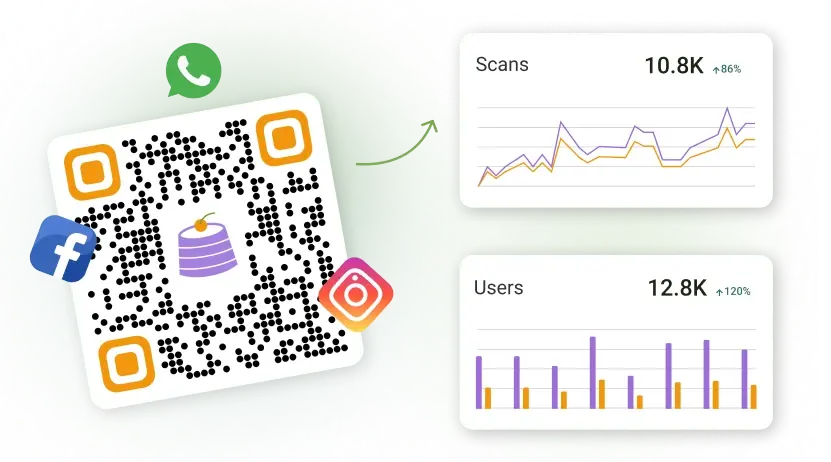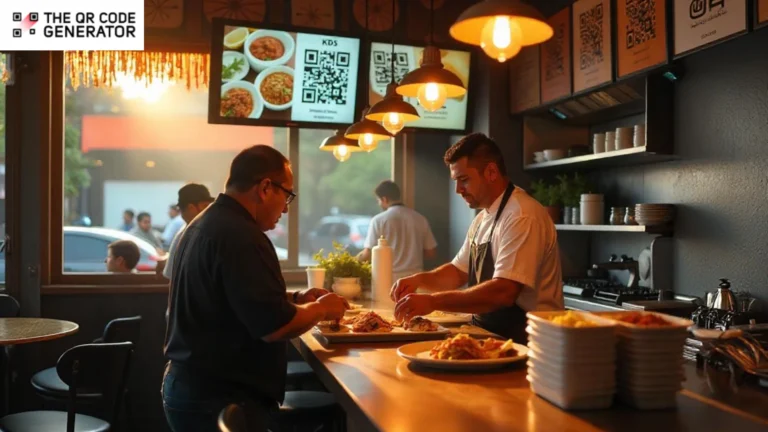Running a restaurant is hard enough without the added stress of missing or wrong orders slowing you down. You’ve seen it happen: a ticket goes missing, an order is misheard, or a note smudges during the rush. Suddenly, the wrong dish goes out, and you’re wasting time and ingredients fixing an avoidable mistake.
Manual order relays slow you down and hurt your bottom line. In fact, human errors at a restaurant can cost up to $9,000 every month. While most restaurants try to reduce these mistakes, few have reliable processes to eliminate them entirely.
Here’s a simple solution: QR Codes linked to a kitchen display system (KDS).
With just one scan, orders go straight from your guest’s phone to your kitchen screen—quickly, accurately, and without complex POS setups. It’s a lightweight upgrade that improves order speed, minimizes mistakes, and frees up your team’s attention for service.
To understand why this shift is needed, you must look at what manual orders are costing you.
Table of contents
- The hidden costs of manual orders in your restaurant
- Using QR Codes to send orders to your kitchen without a POS
- How do QR Code-triggered kitchen displays improve accuracy and speed?
- How to set up QR Codes for kitchen display workflows
- What are some best practices when using QR Codes for kitchen displays?
- Turn every order into an advantage
- Frequently asked questions
The hidden costs of manual orders in your restaurant
One wrong order during a lunch rush means a remake, a frustrated customer, and your team scrambling while new orders pile up. Here’s what’s really at risk when you rely on paper tickets and manual order relays:

1. Missed or misheard orders
Shouting orders across the counter or scribbling on paper leads to misheard details and lost tickets. This results in remakes, wasted ingredients, and longer wait times, hurting both your table turnover and online reviews.
2. No central view of active orders
When your team can’t see all active orders in one place, they waste time asking, “What’s next?” Prep and cooking are delayed until the waitstaff hand off orders, slowing service and cutting into efficiency, especially during your busiest hours.
3. Missed modifiers and allergies
“Extra spicy,” “no cheese,” or “gluten-free” are easy to overlook in manual systems. That’s not just a poor guest experience but a health risk too. Over 32 million Americans have at least one food allergy, making accurate, visible order details essential for customer safety and trust.
4. Delayed service during busy hours
Having staff walk orders from the table or counter to the kitchen creates bottlenecks. This physical handoff wastes time and pulls your team away from higher-value tasks such as customer service and planning. When the orders surge, this delay only gets worse, leaving your team overwhelmed.
These manual hiccups don’t just slow you down; they drain valuable time, reduce team focus, and create a poor guest experience. The good news? There’s a smarter and more straightforward way to manage orders without overhauling your entire system. A simple restaurant QR Code linked to a kitchen display can eliminate these issues and help your team serve faster with fewer mistakes.
Using QR Codes to send orders to your kitchen without a POS
You do not need a complicated point-of-sale (POS) system to get orders to your kitchen quickly and clearly. Most POS and kitchen display systems are expensive and require setup, integration, and staff training. Hence, they’re a poor fit for small restaurants or those just starting out.
QR Codes offer a simpler, affordable alternative. There is no tech-heavy setup, no steep costs, just a clean, real-time view of orders on any screen.
Adding QR Codes to your setup also gives your guests a fast way to send orders while giving your kitchen a clear, organized view of what needs to be done next. This keeps your team moving smoothly, even when your restaurant is full.
Here is how this works in a real kitchen:

1. Guests scan a QR Code and place their order
You can use The QR Code Generator (TQRCG) to create a QR Code that links to your digital menu or order form. Guests scan the code on their table tent or at the counter, view your menu, and place their orders independently. This removes the need for paper tickets or manual relays.
2. Orders appear on your kitchen screen
You don’t need to print tickets or use a POS system. Instead, incoming orders can appear on a tablet, laptop, kitchen monitor, or whatever fits your setup.
Your team can:
- View orders in a Google Sheet that updates automatically.
- Monitor orders using form submissions from Google Forms, Tally, or Airtable.
- Check a shared inbox if your form sends orders by email.
- Use a dedicated URL that shows live order data.
This setup ensures your kitchen sees each order clearly with all the information, such as modifiers, table numbers, etc., without relying on handwriting or verbal relays.
3. Your kitchen prepares orders without confusion
When orders appear in real time, your kitchen team can see exactly what was ordered, when it was ordered, and any special requests that need attention. This clear view helps your team plan prep steps, manage cooking times, and prioritize orders based on when they arrive.
QR Codes also reduce the risk of missed items or duplicate dishes and keep your cooks focused on preparing food rather than chasing down details.
Now, let’s look at how this setup helps your kitchen stay on track.
How do QR Code-triggered kitchen displays improve accuracy and speed?
In a busy kitchen, every second counts. QR Code-triggered kitchen displays ensure your team sees the orders as they come in, helping them reduce mistakes and work efficiently.
Let’s look at this in action with some examples.
1. Orders go straight to a visible screen
When guests scan a QR Code to order, their selections are instantly sent to a screen in your kitchen. Real-time details such as modifiers and timestamps appear immediately, so your kitchen crew can stay focused on prep instead of asking follow-up questions or chasing down missing information. This keeps your workflow smooth, even when the volume spikes.

At Good Good Culture Club, guests scan QR Codes to place contactless orders. These orders go directly into the kitchen, bypassing servers entirely. This significantly reduced order mistakes, cut labor strain, and allowed their staff to focus more on enhancing the guest experience.
Pro tip: You can use a monitor or a smart TV to serve as your kitchen display, making this setup low-effort to implement without a heavy investment.
2. Prep status and order sequence are easy to track
Digital QR Code orders come with timestamps and appear in the order they’re placed. This helps your team focus on what’s next, reduce delays, and avoid missed tickets, especially when the kitchen is busy.
For example, a fast-casual burger spot uses a live Google Sheet to track orders. During dinner rushes, they highlight orders pending for over 10 minutes to keep prep moving smoothly.
Pro tip: Use visual cues (such as row color changes) to flag aging orders and improve in-the-moment speed.
3. QR Codes ensure accurate table mapping
Placing table-specific QR Codes lets your kitchen know exactly where each order came from. This helps staff deliver food to the right guest without confusion.
Restaurants in India like Wow! Momo and Haldiram use this system across their locations, helping staff deliver dishes accurately while improving the guest experience.
Pro tip: Label QR Codes clearly (Table 1, Table 2) to keep order mapping organized.

4. There is a clear line of responsibility
Time-stamped, QR Code-triggered orders create a record of who did what and when. This builds accountability, simplifies shift reviews, and helps identify workflow bottlenecks after service.
For example, a full-service restaurant routes dessert and drink orders through separate KDS dashboards. The manager uses timestamp data to audit service speed over the week and discovers that the bar consistently lags between 8 and 9 PM.
Pro tip: Use this data in weekly reviews to flag trends, assign accountability, and adjust schedules or prep routines to stay ahead of delays.
5. Language barriers are removed
Digital orders can include icons, structured formats, and multiple languages, helping teams understand orders clearly, even if not everyone speaks the same language.
Many hotels use multilingual QR Code menus to serve a global guest base. When guests scan a QR Code at their table or in-room dining guide, they’re prompted to choose their preferred language. Orders are instantly structured and sent to a kitchen display system, giving staff a consistent, easy-to-read format even if team members don’t speak the guest’s language fluently.
Pro tip: Include simple visuals for common modifiers (e.g., icons for “spicy” or “no nuts”) to improve clarity.
How to set up QR Codes for kitchen display workflows
Switching to QR Codes in your kitchen might seem like a significant change, but it is one of the simplest ways to reduce chaos during busy hours.
You don’t need expensive systems or complicated tools. With the proper setup, you can give your kitchen a clear view of incoming orders and keep everything running smoothly, even on your busiest nights.
Here’s how you can set up a QR Code kitchen workflow that fits your restaurant’s daily reality:
Step 1: Start with your ordering goal
Every kitchen has different pain points. Maybe you’re tired of staff running paper tickets back and forth during peak hours. Maybe you want to support a lean team without dropping order accuracy. Or you might just want a reliable record of what was ordered and when.
Knowing what you need most helps you decide how your QR Code should work for you. This small step saves a lot of hassle later.
Step 2: Choose a QR Code destination that fits your flow
Your QR Code must send orders where your team can see and act on them without delay. Using The QR Code Generator (TQRCG), you can link your code to:
- A digital menu with ordering options (Google Forms, Tally, Airtable).
- A simple form that emails orders to your kitchen.
- A page that logs time-stamped orders for clear tracking.
If your workflow ever changes, you don’t need to reprint the QR Codes. Instead, you can update the destination link using a dynamic QR Code, which you can easily edit anytime.
Step 4: Set up a kitchen display that your team will use
Your setup does not need to be fancy. A tablet, laptop, or even an old phone with a clear screen can become your kitchen display. You can:
- Use a Google Sheet that auto-updates with new orders.
- Get instant form submission email alerts.
- Keep a browser window open to monitor incoming orders.
Step 5: Keep printed tickets if it helps your team
Some kitchens still work best with something they can hold in their hands. If your team likes physical tickets:
- Connect a printer to get order emails or spreadsheet printouts.
- Print directly from your order dashboard.
This can help you ease into a digital system while keeping your team comfortable.
Step 6: Plan for menu updates and flexibility
Menus change, items sell out, and sometimes, orders must be paused to catch up. So opt for dynamic QR Codes to gain more control without extra costs or wasted signage.
With dynamic QR Codes, you can:
- Switch menus for lunch, dinner, or specials
- Pause ordering during rush resets or breaks
- Update prices or items without reprinting codes
Step 7: Place QR Codes where they work best
It sounds simple, but where you place your QR Codes can make or break adoption. Good spots include:
- Table tents and counters that your guests can instantly see
- Kitchen pass or prep stations for internal QR Code workflows
Add clear labels such as “Scan to order” or “Kitchen orders start here” so guests and staff know exactly what to do. This small detail reduces confusion and missed scans.

What are some best practices when using QR Codes for kitchen displays?
Once you set up QR Codes for your kitchen, minor details can make the difference between a smooth workflow and frustration for your team and guests. As mentioned, always use dynamic QR Codes to instantly update menus or specials without needing to reprint.
Here are more suggestions on making QR Code ordering work well in your day-to-day operations.
1. Test scan behavior across devices
Phones and browsers can behave differently when scanning QR Codes. Before going live, scan your QR Code on iOS and Android, using both Wi-Fi and mobile data. Ensure your menu or order form loads quickly and doesn’t require guests to download an app or log in.
A slow-loading page can lead to abandoned orders, hurting your flow and revenue.
2. Train your team to monitor orders
QR Codes only help if your team knows where to look for incoming orders. Assign one team member per shift to monitor your order screen, whether it’s a Google Sheet, dashboard, or inbox.
A quick visual training session helps staff recognize new orders and know what to do next, reducing confusion during busy times.
3. Set up a backup access point
Tech issues happen, often at the worst times. Ensure orders are visible on multiple devices, such as tablets and backup laptops. Store order data in a shared sheet or inbox, so your team can keep things moving if one device fails.
4. Use structured fields for modifiers and notes
Free-text instructions can be misread or misunderstood. Use dropdowns or checkboxes for common modifiers such as spice level, toppings, or dietary needs. You can also include an optional comment box for special notes.
5. Track order times to improve kitchen flow
Timestamps from your form or order sheet can help you track how long orders take from submission to completion. Color-code older orders so your team knows what to prioritize during rush hours. This helps reduce delays and improve prep speed over time
6. Start small, then scale up with feedback
Rolling out QR Codes all at once can overwhelm your team. Start with a few tables or a single service counter. Test it during different shifts and gather feedback from your team and guests. This helps you improve the system before using it across the restaurant.
Turn every order into an advantage
A simple QR Code can transform how your kitchen sees and handles orders, turning potential chaos into a clear, steady flow.
When you align QR Codes with your kitchen’s real workflow, place them where they matter, and build them with your team’s needs in mind, you create a system that feels less like technical and more like teamwork in action. It’s a practical shift that helps you move faster, reduce mistakes, and keep your guests happy.
And the best part? You don’t need a full tech overhaul to see the difference. All it takes is a clear goal, a smartly placed QR Code, and the mindset to turn every order into an opportunity for smoother service.
Ready to give your kitchen the breathing room it needs? Start building your dynamic, kitchen-ready QR Codes with The QR Code Generator today and see how small changes can bring clarity to your busiest shifts.
Frequently asked questions
Yes, you can use QR Codes on your kitchen screens without a POS system. Many restaurants link QR Codes to a Google Form, Tally, or Airtable that sends orders directly to a shared sheet or inbox. This setup helps your team view and manage orders in real time using a tablet or screen without adding extra tech layers.
Kitchen staff see QR Code orders in real time using a shared Google Sheet, a live form dashboard, or an email inbox that updates instantly when a guest submits an order. This helps your team prepare orders quickly and keeps the workflow steady during peak hours.
If a QR Code order does not show up, it helps to check your internet connection and confirm your form or sheet settings are correct. Having a second device open with the same dashboard can give your team a backup view, reducing the chance of missing orders during busy times.
Dropdown menus and checkboxes for items and modifiers on your order form can reduce incomplete orders. Adding a clear reminder at the start of your form, asking guests to double-check their orders before submitting, helps guests feel confident and keeps orders accurate.
You can create different QR Codes for specific menus or stations, such as salads, drinks, or hot food, and link each QR Code to its own form or sheet. This helps your team receive only the orders they need to prepare, which keeps each station focused and organized.
Using unique QR Codes for each table or adding a required “Table Number” field on your form helps you attach table numbers to every order. This ensures your kitchen team knows where each order needs to go, which keeps service clear and organized during busy shifts.







